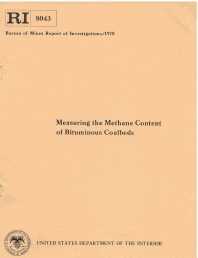Mining Publication: Measuring the Methane Content of Bituminous Coalbeds
Original creation date: January 1975
The methane content of virgin bituminous coalbed can now be measured accurately in the field with exploration core samples from vertical boreholes. The gas content of the coal per unit weight can be used either to design a mine ventilation system or to determine if degasification of the coalbed will be necessary before mining, and to determine the gas resources in the coalbed. The equipment necessary to conduct the test costs less than $50. The gas content of the coal in place in the ground is determined by summing the gas lost from coring, gas measured during desorption, and the residual gas in the coal. Upon removal from the borehole, the core sample is placed in an airtight container and desorbed for several weeks until the desorption rate is below 0.05 cm3/g for 5 consecutive days. The gas lost from the core while it was being cored and the residual gas are estimated by a new graphical method. The amount of gas remaining depends upon whether the coal is friable or blocky. Friability appears to relate to the depth of the sample below the surface, fixed carbon percentage, Hardgrove grindability index, and proximity to tectonic disturbance. Friable coals emit nearly 96 pct of the total gas during desorption whereas a blocky coal emits only 60 pct of its total gas. Coalbeds that are ill defined as to their blocky or friable nature must be tested in the laboratory for unambiguous analysis.
Authors: CM McCulloch, JR Levine, FN Kissell, M Deul
Report of Investigations - January 1975
NIOSHTIC2 Number: 10000625
Pittsburgh, PA: U.S. Department of the Interior, Bureau of Mines, RI 8043, 1975 Jan; :1-22
See Also
- The Borehole Monitoring Experiment: Field Measurements of Reservoir Conditions and Responses in Longwall Panel Overburden During Active Mining
- Degasification System Selection for U.S. Longwall Mines Using an Expert Classification System
- Development and Application of Reservoir Models and Artificial Neural Networks for Optimizing Ventilation Air Requirements in Development Mining of Coal Seams
- Drainage of Methane From the Overlying Pocahontas No. 4 Coalbed From Workings in the Pocahontas No. 3 Coalbed
- Guidelines for the Control and Monitoring of Methane Gas on Continuous Mining Operations
- MCP - Methane Control and Prediction - 2.0
- Modeling and Prediction of Ventilation Methane Emissions of U.S. Longwall Mines Using Supervised Artificial Neural Networks
- Remote Methane Sensors
- Reservoir Rock Properties of Coal Measure Strata of the Lower Monongahela Group, Greene County (Southwestern Pennsylvania), from Methane Control and Production Perspectives
- Stochastic Modeling of Gob Gas Venthole Production Performances in Active and Completed Longwall Panels of Coal Mines
- Content source: National Institute for Occupational Safety and Health, Mining Program


 ShareCompartir
ShareCompartir
